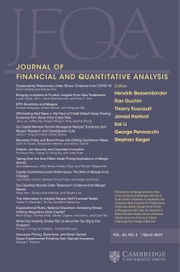Article contents
Board Ancestral Diversity and Firm-Performance Volatility
Published online by Cambridge University Press: 14 September 2018
Abstract
We proxy for board members’ opinions and values using directors’ ancestral origins and show that diversity has costs and benefits, leading to high performance volatility. Consistent with the idea that diverse groups experiment more, firms with ancestrally diverse boards have more numerous and more cited patents. In addition, their strategies conform less to those of the industry peers. However, firms with greater ancestral diversity also have more board meetings and make less predictable decisions. These findings suggest that diversity may lead to inefficiencies in the decision-making process and conflicts in the boardroom.
Information
- Type
- Research Article
- Information
- Copyright
- Copyright © Michael G. Foster School of Business, University of Washington 2019
Footnotes
We thank an anonymous referee, Ken Ahern, Tom Bates, Alon Brav, Aiyesha Dey, Jarrad Harford (the editor), Andrew Karolyi, Alberto Manconi, Ron Masulis, David McLean, Joseph Pacelli, Oliver Spalt, and participants at the 2016 Association of Financial Economics/Allied Social Sciences Association meeting, the 2015 Ackerman Conference on Corporate Governance, the 2016 Society of Financial Studies Cavalcade, the U.S. Securities and Exchange Commission (SEC), the University of Rome III, the University of Lancaster, DePaul University, the University of Central Florida, and the Hong Kong Baptist University for comments. Giannetti acknowledges financial support from the Tom Hedelius and Jan Wallander Foundation. The SEC, as a matter of policy, disclaims responsibility for any private publication or statement by any of its employees. The views expressed herein are those of the author and do not necessarily reflect the views of the SEC or of the author’s colleagues on the staff of the SEC.
References
- 140
- Cited by

